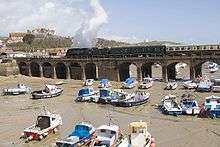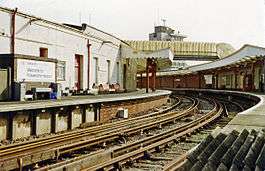Folkestone Harbour railway station
| Folkestone Harbour | |
|---|---|
|
Tracks running into the station | |
| Location | |
| Place | Folkestone |
| Area | District of Shepway |
| Operations | |
| Platforms | 2 (latterly 1) |
| History | |
| 1 January 1849 | First station opened |
| 1856 | Station resited |
| 29 November 1915 | Temporary closure |
| 1 March 1919 | Reopened |
| 4 September 1939 | Temporary closure |
| 1945 | Reopened |
| 2001 | Station closed to regular traffic |
| 2009 | Line closed to all traffic |
| 2014 | Line officially closed |
| Disused railway stations in the United Kingdom | |
|
Closed railway stations in Britain A B C D–F G H–J K–L M–O P–R S T–V W–Z | |
|
| |
Folkestone Harbour station was a railway station built to serve the port of Folkestone in Kent, one of three stations in the town. It was at the end of the short 1-in-30 Folkestone Harbour Branch Line, joining the South Eastern Main Line at Folkestone Junction. The branch and harbour station provided a rail connection for boat trains from London which connected with the ferry services to Calais and Boulogne.
The branch and station closed to regular passenger train services in 2001 although the line and station continued to be used by the Venice-Simplon Orient Express (VSOE) and railtours until 2009. An occasional inspection train used the line until the line was officially closed on 31 May 2014.
History
Folkestone Harbour was in decline in the 1830s, as Dover became an increasingly important cross-channel port. The harbour was acquired by the South Eastern Railway (SER) in August 1843 for redevelopment. Almost immediately, a branch line to it was planned.[1]
The line was built in 1844 leaving the main line at Folkestone Junction and was double tracked ending with a viaduct across the harbour itself. In 1847, a swing bridge allowed the line to reach the southern pier[2] and, in 1848, the line was passed by the Board of Trade for passenger use.[3] The station was opened on 1 January 1849, but was replaced by another on a different site in 1856.[4] This second station went through periods of temporary closure: from 29 November 1915 until 1 March 1919; from 4 September 1939 until 1945; from 13 to 20 March 1960; and between 1 January and 11 April 1992.[4]
The line was electrified at the same time as the main line during the "Kent Coast Electrification - Stage 2" in June 1961, and passenger trains were formed of electric multiple units. Freight services were withdrawn on 17 August 1968.[2]
In 1994, the opening of the Channel Tunnel led to the majority of ferry operators moving to other ports in the South East, with the result that only two services per day were arriving at Folkestone Harbour, to connect with the Hoverspeed SeaCat services. When these were moved to Ramsgate, the station closed to ordinary rail traffic in 2001.
Sometime after 2001, the line was singled for operational purposes, although the disused line is still in position.
Branch Line
The branch is short but sharply inclined meaning that steam engines had to be banked. For most of its life, its main traffic was passengers travelling on boat trains direct to London, albeit with a change of direction (reversal) at Folkestone East.
Services
Until 2009, Venice Simplon Orient Express operated two scheduled services per week to Folkestone Harbour on its London to Paris route, which ran on Thursday and Sunday between March and November when the British Pullman service terminated there. Passengers were transferred by coach to the Eurotunnel terminal, where they joined a Eurotunnel Shuttle to Calais to pick up the Orient Express in France.
_on_the_climb_from_Folkestone_Harbour_(24_January_2009).jpg)
Closure
Folkestone Harbour station is located at the end of a viaduct which separates the port's inner and outer harbours, which in turn is the end of the spur railway separate from the main line. The proposals for the regeneration of the Harbour area will see up to 1000 new houses and apartments, but the route followed by the branch line means that it does not offer a viable means of transport to serve this new development. Network Rail decided that it could not justify spending considerable amounts of public money to maintain and upgrade the route, so it began a process that would see the Folkestone Harbour branch closed permanently. The viaduct, which is listed, is to be retained as part of a new pedestrian route to the harbour arm, but the track on the rail spur will be lifted.[5]

On 12 April 2008, a closure ceremony, together with an official last train took place.[6] However, objections were raised by DB Schenker, the Department for Transport and Southeastern. During 2008, VSOE still used Folkestone Harbour with its last train travelling on 13 November[7] and a number of rail tours visited the branch. Advertised as the last train, a steam hauled rail tour visited the branch on 14 March 2009.[8] Reliant on closure of the line, a proposed Folkestone Harbour and Seafront Masterplan included plans to demolish the viaduct to make way for a new marina.[9] An association opposing the closure was formed, with the primary aim of gaining control of the branch either through purchase or a lease with an option to buy.[9] The group, called the Remembrance Line Association proposes turning it into a mainline connected heritage railway, a 'Leaving for War' museum and a memorial dedicated to the troops that arrived on trains to the branch and left on ships to fight in both World War I and World War II.[9] It also proposes hosting regular national railtours to the branch, and would permanently operate a tourist shuttle service up and down the 1in30 gradient, utilising its own rolling stock and locomotives. Further plans include a revived passenger ferry to Boulogne. On Sunday, 21 December 2008, the Remembrance Line Association ran a railtour to the branch using the Southern Railway preserved diesel electric Class 201 No. 1001.[10]
On 20 March 2009, Network Rail announced they had begun the formal process to close the line and station on cost grounds, having redeveloped Folkestone West with new waiting facilities for the VSOE passengers. However, up to August 2010, the closure process had not proceeded past the statutory 'mothballing' stage, making the railway still officially operational. This was to allow protracted negotiations between all interested parties to run their full course to ensure the optimum benefits for the Folkestone Harbour statutory port area and to fully investigate heritage, conservation and other planning issues pertaining to the Shepway District as a whole.[11]
On 20 November 2013 the Department for Transport published a proposal to close the line and station serving Folkestone Harbour. Consultation on the closure ended on 28 February 2014,[12] and the line was formally closed on 31 July 2014.[13] [14]
References
Citations
- ↑ Gray 1990, p. 259.
- 1 2 "Kent Rail Folkestone Harbour". Kentrail.org.uk. 2008-04-12. Retrieved 2013-12-01.
- ↑ "Folkestone Harbour Station". Ruthparkinson.co.uk. Retrieved 2013-12-01.
- 1 2 Butt, R.V.J. (1995). The Directory of Railway Stations. Yeovil: Patrick Stephens Ltd. p. 98. ISBN 1-85260-508-1. R508.
- ↑ Folkestone Harbour Masterplan Archived 6 November 2006 at the Wayback Machine.
- ↑ Railway Herald Issue 127
- ↑ Railway Herald Issue 155
- ↑ Railway Herald Issue 170
- 1 2 3 Steam Railway Magazine, Issue 360, 6 March - 2 April 2009
- ↑ "HDL Christmas Onward Tour In conjunction with The Remembrance Line Association Ltd". Hastings Diesels. 30 December 2008. Archived from the original on 20 March 2009. Retrieved 20 March 2009.
- ↑ "A New Era for Folkestone Harbour". www.networkrailmediacentre.co.uk News Releases: London & South East. Network Rail. 20 March 2009. Archived from the original on 20 March 2009. Retrieved 20 March 2009.
- ↑ Department for Transport (2013-11-20). "Folkestone Harbour: closure of branch line and station - Consultations". GOV.UK. Retrieved 2013-12-01.
- ↑ http://orr.gov.uk/__data/assets/pdf_file/0014/13334/stn-closure-ratiification-notice-folkstone.pdf
- ↑ http://orr.gov.uk/what-and-how-we-regulate/station-and-depot-access/station-and-depot-closures
Sources
- Gray, Adrian (1990). South Eastern Railway. Middleton Press. ISBN 978-0-906-52085-7.
Further reading
- "Folkestone - Boulogne 1843 - 1991" by John Hendy, published by Ferry Publications Ltd
External links
- Orient Express train times
- Folkestone Harbour station information from kentrail.co.uk
- History of Folkestone harbour
- The Remembrance Line Association
- Folkestone Harbour and Seafront Masterplan
Coordinates: 51°04′41″N 1°11′15″E / 51.0781°N 1.1874°E
